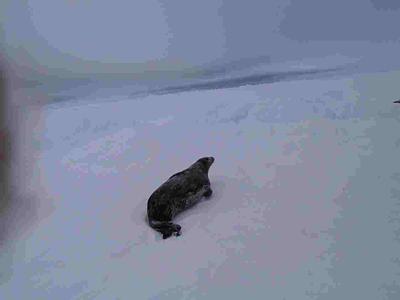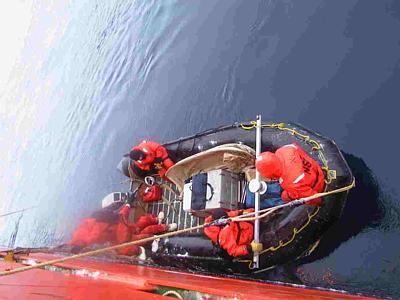
|
|
13 March, 2000
Anthropomorphism Concluded- the Alien's Viewpoint
71 18 s, 106 50 w
Ship heading south at 7 knots (8mph), dark, snow flurries, no stars
Depth 517 m (1696 ft)
Temp 0.5 C (31 F)
Winds NE @ 31 knots (36 mph)
We've left the continental shelf break, proceeding south along 107 w, to
Thwaites Glacier Tongue
Note: The Nathaniel B. Palmer has been having e-mail difficulties, so you
may view this entry before earlier ones, although they were posted
sequentially. I will get them all posted here as soon as I can! LR
In between cores, sleeping, trips to the galley, exercise and
fiddling I've been spending time in the ice tower. Recently we were
watching and counting, when the ship came upon a large, stable looking
floe. Five Weddell Seals were pulled out, basking and resting. Brad of the
seal people called to the bridge, or the bridge called to us, I don't
remember which. Brad and the bridge discussed the possibility of stopping
so that he and Sue could get out and gather data and DNA samples from the
floe's occupants.
As I mentioned in one of my earlier journal entries, one of the
goals of the APIS (Antarctic Polar Ice Seal) project is to determine if
the four pack ice seal species- Crabeaters, Leopards, Ross and Weddell
Seals- move around, either seasonally or in their lifetimes. One way to
determine if these animals form distinct population groups, or move and
interbreed, is by DNA analysis.
At first I wondered why such an expensive and complicated method was
needed. It seemed to me that the logical way to get information about
seals' movements would be to tag them, in the same way birds are banded. In
fact Sue and Brad carry little yellow cattle ear tags which can be attached
in the webbing between flipper sections, but they don't use them. Brad
explained that since Antarctica is so sparsely populated and remote (by
people's standards) the possibility of a tagged seal ever being seen again
was remote. Tagging required wrestling with the animal or sedating it, and
both are time taking and potentially dangerous procedures. In some
situations, especially with the local population of seals around McMurdo
Sound, tagging has given valuable data about life span and reproduction.
There is also the radio transmitter tagging I referred to in an earlier
journal. But DNA analysis seems to be the best way to get the large scale
information that APIS seeks. It's the same technique used in crime
investigation, but in Antarctica it's used for a much happier purpose.
The first step in roast chicken is to catch the chicken, and to analyze DNA
you of course need to get some DNA. There are two ways the seal people use
to get a DNA sample. One is a device like a nail clipper used to remove a
sample from the tip of a flipper. The other gadget is mounted on the end of
a pole, and removes a small plug of skin and hair, a sample a little
smaller than a pencil eraser. The pole-mounted sampler is safer to use with
larger animals or Leopard Seals, because the biologist can stay away from
teeth, poking from a distance. There's a hilt on the sampler to keep it
from going in more than absolutely necessary, less than 1 cm. Either way,
it probably hurts the seal a little, but not for long. As a matter of fact,
I watched one flipper sample where the seal slept through the whole thing.
Seals seem more disturbed by the closeness of people, and once scientists
are five meters away, the seals lose interest.
The DNA samples are labeled and frozen. Each tiny sample will be divided
into halves, each half going to a different lab for analysis. The labs
themselves further divide their samples, using part for analysis and
keeping part frozen for future use. Like the cores and CTD information, DNA
data for seals is expensive and hard to come by. The samples are worth much
more than gold.
Sue, Brad and the bridge agree that the floe is thick and stable enough,
and that the ship can be maneuvered to a position where the bow crane will
be able to set us down safely. On the radio, we hear the bridge calling for
a winch operator, and we start down the three ladders and four sets of
stairs to the labs where our clothing and equipment is stored. Brad is in
front and ahead. I am second, and Sue is behind me. I'm moving along, but
not in a real hurry. Behind me Sue urges me to speed up. She is afraid that
the seals will be scared off the flow or that we will delay the ship too
long. I quicken my pace.
As we pass my room, I grab mittens and liners, a sweatshirt, a button on
flannel hat, and my bunny boots. Bunny boots are big and cumbersome but
superbly insulated rubber boots. They are white and look silly, even to me
(I'm not exactly a slave to fashion in the best of times.) I put on two
sets of socks and the boots and hurry to the main deck. Once there I find a
red float suit. The suit is like very bulky coveralls, and is good
protection against wind, cold and wet. More importantly, it acts as a life
preserver if you go through the sea ice or into a snow covered crack
between floes. Of course I can't get the float suit on over the bunny
boots, so I have to sit down on the floor and take the boots off, put the
suit on with its zippers and buckles, and then put the boots back on. All
this takes time. Finally I'm organized, and head clumsily back up two
flights of stairs to the bow deck.
Brad and Sue are already there, and soon we are ready to "accomplish a
grantee personnel transfer to the ice surface," which is short for "get
off." We stand on a two meter diameter red padded disc equipped with a
triangle of rope nets. The ropes meet over our heads at a ring where the
wire cable from the bow crane attaches. We hold on to the ropes, and are
quickly lifted up and over the rail. We hang there ten or fifteen meters
above the floes, and then descend to the surface. I enjoy the ride.
We start off in the direction of the seals, which are now hidden from our
view by a pressure ridge. Walking in the snow is even clumsier than on the
ship. Sue and Brad are ahead, constantly poking at the snow with aluminum
poles to see if the walking is safe. I carry a throwing rope coiled in a
little red bag. If somebody goes through, I can hold one end and toss the
bag, and the rope will uncoil as the bag goes through the air. I walk where
one of my companions has already walked, on the assumption that if the ice
is strong enough for them it is strong enough for me. I keep the borrowed
digital camera hanging down inside the neck of my float suit, so that its
batteries will stay warm enough to get some pictures. A lone Adelie Penguin
sees us coming and runs off in quick short steps, waving its wings and
looking around at us as it goes.
We cross several soft areas where our boots get wet, over an area of rough
and uneven old pressure ridge, and step over a blue crack between two
floes. I think of stories of explorers, trying to make their way over pack
ice from crushed ships to bleak land. It would take a long time to walk 100
kilometers over the pack ice. It would seem even longer if you knew that
all you had to look forward to was wet black rock and an uncertain rescue.
As we approach the seals, they don't seem alarmed. Ten meters away we stop
and look at them. One adult seal wriggles lazily over to the edge of the
ice, sticks its head underwater, and rolls and slides into the ocean. Two
don't even look up. Sue takes her yellow notebook out of her red coat
pocket and begins writing. They are all Weddell Seals, and one is a pup
born late in 1999. I look at them carefully, trying to answer the obvious
question: are they male or female? I ask Sue. She tells me that there is no
certain way to tall the difference until one urinates. Female seals urinate
from a point near their flippers, while male's urine emerges at a point
further towards the head end.
Brad and Sue decide they will try to sample the pup first. Brad approaches
it, talking in a low and reassuring manner, but the pup is now decidedly
nervous. Sue moves in and stands in front of the seal, waving the red flag
in its face. The seal's attention is diverted from Brad, who with a quick
and graceful move clips a bit of the hind flipper. There is no bleeding. We
all move back, and the seal stops struggling and once again looks at us
with a curious stare. Brad and Sue bag and label the sample, and Sue writes
some more notes.
We sample the other seals, while those already attended to and others yet
to be sampled look on curiously. One seal is an old white whiskered
Weddell, and the other two are adult Weddell males. The seals roll over
beautifully, and arch their bodies gracefully when Sue and Brad are getting
their DNA. Sue works at one of the adults with the pole sampler while Brad
waves the flag. Even with her experience she is having difficulty because
the seal is wiggling so adeptly, but she gets her sample in the end.
When we are done, we take a last look at the seals and start returning to
the ship. Two seals already appear to be back to sleep, but the pup
continues to watch us. We are hoisted back on the ship. The diesels
increase their pitch slightly, and the ship begins to move off. When I look
back, all four seals have returned to basking, as if we'd never been there.
(Pictures of Sue, Brad and the seals are posted with the March 11 journal
entry.)

An adult Weddell Seal, having lost interest in science, moves away to find a good napping place.

The ice people return from a cold session on a nearby floe.

The business end of a sedated Leopard Seal. The biggest teeth are about 10 cm apart, which matches the spacing of the scars on many Crabeater Seals. (Dan Naber Photo)
Contact the TEA in the field at
.
If you cannot connect through your browser, copy the
TEA's e-mail address in the "To:" line of
your favorite e-mail package.
|
